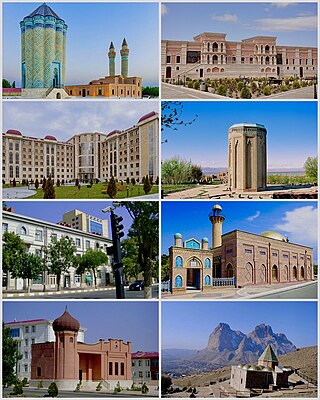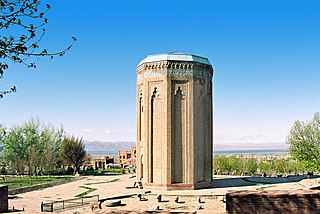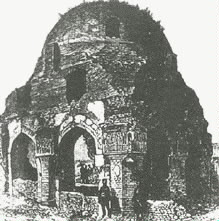
Nakhchivan is the capital and largest city of the eponymous Nakhchivan Autonomous Republic, a true exclave of Azerbaijan, located 450 km (280 mi) west of Baku. The municipality of Nakhchivan consists of the city of Nakhchivan, the settlement of Əliabad and the villages of Başbaşı, Bulqan, Haciniyyət, Qaraçuq, Qaraxanbəyli, Tumbul, Qarağalıq, and Daşduz. It is spread over the foothills of Zangezur Mountains, on the right bank of the Nakhchivan River at an altitude of 873 m (2,864 ft) above sea level.

Itchan Kala is the walled inner town of the city of Khiva, Uzbekistan. Since 1990, it has been protected as a World Heritage Site.

Konye-Urgench, also known as Old Urgench or Urganj, is a city of about 30,000 inhabitants in north Turkmenistan, just south from its border with Uzbekistan. It is the site of the ancient town of Gurgānj, which contains the ruins of the capital of Khwarazm. Its inhabitants deserted the town in the early eighteenth century in order to develop a new settlement, and Konye-Urgench has remained undisturbed ever since. In 2005, the ruins of Old Urgench were inscribed on the UNESCO List of World Heritage Sites.

Momine Khatun Mausoleum is a mausoleum, also known as the Atabek Dome, located in the city of Nakhchivan of the Nakhchivan Autonomous Republic in Azerbaijan. It was built in 1186 by the architect Ajami ibn Abubekr Nakhchivani. The ten-sided mausoleum reached a height of 34 meters. Today its height is only 25 meters. The mausoleum, built and named after the mother of one of the local rulers of Azerbaijan, Atabek Jahan Pahlavan of Ildegezid dynasty, is masterfully decorated with complex geometric ornaments and inscriptions from Koran.
The architecture of Azerbaijan refers to the architecture development in Azerbaijan.
Xanəgah is a village and municipality in the Julfa District of Nakhchivan, Azerbaijan. It is located 37 km in the north from the district center, on both banks of the Alinjachay River, on the slope of the Zangezur ridge. Its population is busy with vine-growing, farming and animal husbandry. There are secondary school, cultural house, three libraries, communication branch, club, kindergarten and a medical center in the village. It has a population of 1,212. The Əlincəçay xanəgahı of the Middle Ages is located in the east from the Khanagah village, on the left bank of the Alinjachay River.

The memorial complex of Chor-Bakr was built over the burial place of Abu-Bakr-Said, who died in the year 360 of the Muslim Calendar, and who was one of the four of Abu-Bakrs (Chor-Bakr) – descendants of Muhammad. The complex includes the necropolis of family tombs, and courtyards enclosed with walls. It is located in modern-day Kalaya, Uzbekistan.

Juma Mosque (Azerbaijani: Cümə məscidi, or Friday Mosque, is a mosque in Baku, Azerbaijan.

Juma Mosque of Shamakhi or Juma Mosque of Shamakhi is a mosque in the city of Shamakhi, Azerbaijan.

The Mausoleum of Yusif ibn Kuseyir was built in 1161–1162, in Nakchivan city. Architect of the mausoleum was Ajami ibn Abubakr Nakhchivani.

The Karabakhlar Mausoleum is a mausoleum located in Garabaghlar village of Kangarli District of Azerbaijan, about 30 kilometers far from the north-western part of Nakhchivan.

The architectural school of Nakhchivan is one of architectural schools developed in medieval ages on the territory of modern Azerbaijan. It was founded by Ajami Nakhchivani in the 12th century. The mausoleums of Yusif ibn Kuseyir and Momine Khatun, constructed by him in Nakhchivan are a classical example of constructions of this school.

Juma Mosque of Nakhchivan or Friday Mosque of Nakhchivan – is one of monumental constructions of the Atabegs’ Architectural Complex in Nakhchivan, Azerbaijan. The architectural monument demolished in the 20th century is documented in images and photos from the 19th century.

Mamluk architecture was the architectural style that developed under the Mamluk Sultanate (1250–1517), which ruled over Egypt, the Levant, and the Hijaz from their capital, Cairo. Despite their often tumultuous internal politics, the Mamluk sultans were prolific patrons of architecture and contributed enormously to the fabric of historic Cairo. The Mamluk period, particularly in the 14th century, oversaw the peak of Cairo's power and prosperity. Their architecture also appears in cities such as Damascus, Jerusalem, Aleppo, Tripoli, and Medina.
Ahmad ibn Ayuub al-Hafiz Nakhchivani was an Azerbaijani medieval architect. Ahmad Nakhchivani was the most eminent representative of Nakhchivan-Maragha architectural school and two buildings constructed by him are saved up to present days. One of these buildings is Barda Mausoleum (1322) and the other is Garabaghlar Mausoleum built in honour of Gudi khatun (1330s).

The Zumurrud Khatun Mosque and Mausoleum, also known as the Tomb of Sitta Zubayda, is a historic mosque and shrine located in Baghdad, Iraq. It dates back to the Abbasid era. It is located in Sheikh Maarouf Cemetery in the Karkh side of Baghdad, and the site was built at the patronage of Zumurrud Khatun and her son. Zumurrud Khatun was mother of the 34th Abbasid Caliph Al-Nasir, and wife of the 33rd Abbasid Caliph Al-Mustadi. She collected the waqf money from madrasas and built her mausoleum before her death, which is located in Karkh.

The Nakhchivan Autonomous Republic is one of the touristic regions of Azerbaijan with its flora and fauna, climate, and ancient cultural monuments. Nakhchivan is known for its historical monuments such as Momuna Khatun, Yusif ibn Kuseyir, Gulustan tombs, and Garabaghlar. There are other touristic places like Babek castle, Kilit cave, Alinja castle, and Gamigaya in Nakhchivan.
The High Middle Ages, or Classic Feudalism Period in what constitutes the present-day Republic of Azerbaijan, lasted from around the 11th century to the 15th century AD. The High Middle Ages were preceded by the Early Middle Ages and were followed by the Late Middle Ages, which ended around the 15thcentury AD. Key historical trends of the High Middle Ages include the incorporation of the territories that constitute present-day Azerbaijan into the Seljuk Empire, the establishment of the Eldiguzids, the Mongol invasions and the rule of the Ilkhanate, the invasions of Timur and the establishment of the Turkoman Kara Koyunlu and Aq Qoyunlu tribal confederations.

Abdul Vahab Rahim oglu Salamzadeh, was a Soviet-Azerbaijani art critic, architect, doctor of art history, and academician. He had served as the deputy director of the Institute of Architecture and Art of the Academy of Sciences of the Azerbaijani SSR, and head of the department of history and theory of architecture in the same institute, and received the title of Honoured Builder of the Azerbaijani SSR.

















